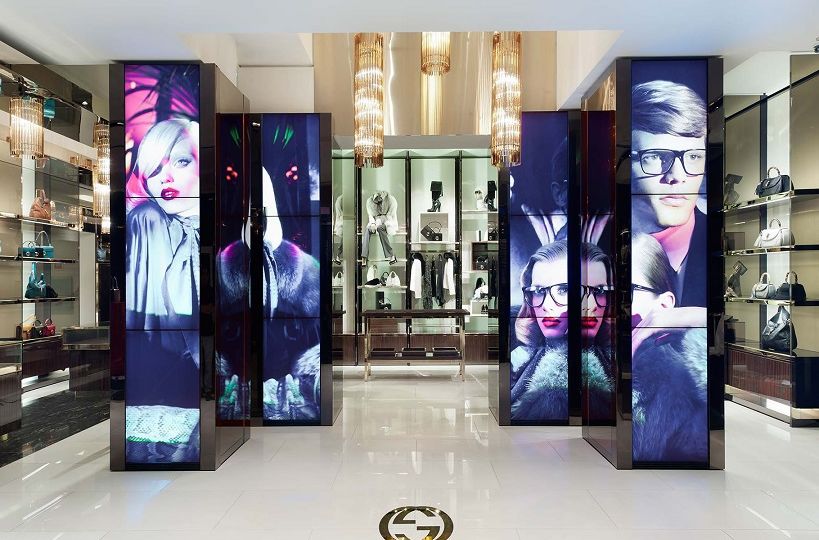 Retail is in the midst of a technological renaissance. New software and audiovisual technologies are offering retail owners greater customer insights and more engaging marketing platforms while simultaneously providing guests with more personalized, streamlined shopping experiences. By combining various types of digital displays with technologies including touch screens, facial recognition, machine learning and mobile device integration, retailers can gather data and make decisions faster and more effectively than ever before.
Retail is in the midst of a technological renaissance. New software and audiovisual technologies are offering retail owners greater customer insights and more engaging marketing platforms while simultaneously providing guests with more personalized, streamlined shopping experiences. By combining various types of digital displays with technologies including touch screens, facial recognition, machine learning and mobile device integration, retailers can gather data and make decisions faster and more effectively than ever before.
Here we will examine emerging trends to determine how retailers can gather valuable anonymous customer data, personalize the shopping experience, engage customers with interactive displays and turn stores into destinations.
Big Data And Personalization
It’s hard to find a piece of modern technology that isn’t collecting data in order to personalize or optimize the user experience. For retailers, collecting and analyzing data on customer behaviors can influence decisions on store designs, staffing, sales promotions and the design and placement of in-store advertisements. The more actionable data a store can generate, the more opportunity it gains to improve ROI from its digital infrastructure.
Recent advances in display and camera technologies have made data collection a passive process that doesn’t require consumer action. For instance, data captured by new camera and motion sensing solutions can help retailers determine how long shoppers take to make decisions, which advertisements are most effective and even which floor plans best enable shoppers to find their desired items.
When paired with digital signage displays and touch screen kiosks, these cameras and software can be used to answer questions such as “how do customers feel about this advertisement?”, “how many people saw this ad today?” or “how long do people spend searching for their desired item?” — enabling retailers to design their floor plans and digital marketing more effectively. If certain campaigns or times of day exhibit low traffic, managers can adjust messaging and work schedules to optimize operations.
Mobile Integration
Personalized information also can be used to create an omnichannel sales funnel, with timely and relevant marketing messages delivered both in-store and through branded mobile apps that offer “push” alerts to promote in-store-only discounts or products. At-home reminders have been a boon for prescription retail customers, for instance, leading to a jump in prescription sales based on timely messages about the need for refills. This ability to reach customers at any time and any place makes every day a new opportunity to share promotions and encourage in-person visits.
Stores also can offer unprecedented in-person experiences that leverage information about past purchases, seasonal trends and even which available in-store ads are most relevant for specific customers. This can be achieved through advanced digital signage displays that interface with smartphones, alerting a store’s network that this particular customer is looking at this particular display, and would be best served with this information or advertisement.
Leading retail experts warn, however, that brands should be careful not to introduce distractions to the in-person shopping experience while customers are on-site. The digital experiences in a physical store should use engaging displays or interactivity to connect the customer to the store and create a memorable experience that doesn’t rely on a mobile device.
Interactivity Is King
According to the Nielsen Total Audience Report, adults in the United States spend an average of 11 hours each day listening to, watching, reading or generally interacting with media. As this trend has grown, especially the explosive popularity of touchscreen mobile devices, people have come to expect digital screens and interactivity to be a part of more and more experiences. Whether a store is selling clothing or video games, interactive digital displays and systems can provide zero-labor customer engagement that encourages purchases and provides a hands-on service that online shopping can’t match.
One of the world’s largest technology retailers consistently introduces new product displays and in-store marketing campaigns. In one of the store’s latest product-specific campaigns, eight locations each received three custom-designed LG LCD display kiosks that present motion-activated ads, tutorials and demos for Microsoft’s Xbox, Windows and Office products. To maximize their value, the kiosks include proximity sensors that activate call-to-action ads and promotional videos when people walk near it, as well as refreshing content based on engagement time so shoppers are prompted to move through information or a demo in a timely manner.
The Office kiosks feature a 55-inch display on each side, with the backside displaying ads and the front showing tutorials and interacting directly with two attached laptops visitors can use to try the software and follow along with the demo. The Xbox kiosk is similar, with a front display offering two Xbox controllers where guests can play a predetermined game, and a rear-facing 55-inch display that can be seen from throughout the store highlighting game play from top titles.
The last kiosk is focused on Windows’ Cortana, Ink and Hello features, and features a 2×3 panel video wall connected to three Microsoft laptops and tablets that allow for multiple simultaneous users. The video wall can show a single stream across all six panels, then when two or three people want to use the kiosk at the same time, the PC that controls the video feeds automatically separates the displays into three separate feeds, so each guest can have a personal experience and explore products at their own speed.
Retail As A Destination
Brands are leveraging interactive and large-scale display technologies to create retail destinations that offer experiences consumers can’t get online. For Razer Inc., a premier brand in the gaming industry, this idea of retail as a destination led to the installation of several LG video walls and standalone displays across multiple locations in five countries, including the new RazerStore in San Francisco and the Razer USA office in Irvine, Calif.
Working with Coast to Coast Computer Products., Razer outfitted its Irvine office lobby with two 1×6 video wall galleries composed of 43-inch LG SM5KC-B displays to communicate key information to employees, business partners and visitors to the location. Meanwhile, at the more public-facing RazerStore in San Francisco, the team used 16 ultra-thin bezel 55-inch LG LV35A panels to build a large 4×4 video wall, with a total screen size of 220 inches diagonal, to offer shoppers an immersive gaming experience unlike any they can get at home or even in competing stores.
To meet the need for wayfinding and promotional purposes, the team also installed standalone 55-inch LG displays throughout the RazerStore using LG SuperSign. With these innovations, Razer has created a space that reflects its position as a leader in gaming hardware and software and directly targets their market of younger consumers.
Designing Outside The Box
Designers and content creators are looking beyond the rectangular, wall-mounted screen to make an impact. Visual merchandising is the bread-and-butter of brick-and-mortar, and now designers can put pixels on surfaces of all shapes, sizes and locations, with the ability to use these non-traditional display arrangements to present single images or a variety of content.
With modern content management solutions, displays can be arranged and hung in any orientation, with content produced specifically for those displays. Imagine a multi-panel video wall that, instead of being a standard rectangle, is turned 45 degrees and mounted as a diamond. Content can then be created that will fit the diamond screen real estate, resulting in an undeniably attractive video solution that’s different from other stores. Content can even play across disparate displays, allowing designers to deliver artistic expressions such as moving images from one screen to another several feet away.
At the same time, ultrawide displays that can be as much as three times as wide as a standard TV can be used to turn columns into digital artwork, wayfinding or advertising surfaces, or be hung horizontally to draw guests to product displays or departments. On top of that, an emerging wave of curved and custom-shaped displays is opening opportunities for retail stores to utilize new designs and develop brand-enforcing in-store marketing.
Flagship Stores As Retail Labs
One segment of the market is embracing unique display designs in flagship stores that strive to represent the brand at its best. Chains are using cutting-edge digital displays to build spaces where customers can be engaged at every turn, encouraging interaction and store visits.
The Stella McCartney fashion brand joined this trend when it hired an integration and content development firm to install custom-shaped mosaic LG video walls in the front windows of 11 flagship locations throughout the U.S., Europe and Asia. Using a variety of display sizes in both horizontal and vertical orientations, the team built a variety of video walls, up to three for each location, that feature complex shapes and demand attention from people walking by the storefront. Content is developed specifically to fit each different display mosaic and maximize the screen real estate.
That’s Not All Folks
The incredible variety of AV technologies available and the breakneck pace of innovation offer a plethora of options to bring retail spaces to life and deliver real benefits and ROI. Looking forward, new technologies such as transparent OLED displays that can display stunning visuals, but also become see-through, will open even more opportunities to build exciting, memorable in-store moments that elevate the shopping experience.
Whether they are collecting data to improve operations, connecting with mobile apps to offer new benefits, enabling new communal retail spaces, encouraging interactivity or helping malls energize underutilized spaces, digital display technologies are changing how retail stores run and reach their customers. As more chains recognize the benefits they can reap from technology upgrades, the popularity of these installations will grow and may even become a standard inclusion in the design process. For retailers large and small, the time to differentiate is now.
Dan Smith is Vice President of Business Development for LG Business Solutions USA.




